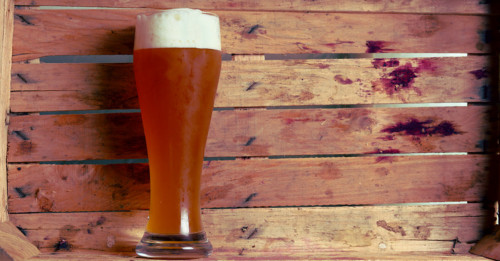In the big global beer family, American wheat beers are related to German Weissbiers and Belgian Witbier, among others, basically anywhere a proportion of wheat (malted or unmalted) has been added to the grain bill before brewing. But because brewing styles, yeast strains, and other factors tend to change once you’ve crossed an ocean, it’s good to get to know the American style on its
American Pale Wheat Ale Essential Info
- Color: Golden; often cloudy
- ABV: 5%-7%
- Commercial Examples: Lagunitas A Lil Sumpin’ Sumpin’ Ale, Harpoon Hefeweizen, Sam Adams Summer Ale
Like a Hefeweizen, an American Pale Wheat Ale is made with a significant proportion of wheat in the grain bill and will look a bit opaque (not totally clear, a result of proteins from the wheat). But an American Pale Wheat Ale won’t have any of the banana or spice flavors commonly associated with a Hefeweizen, because those flavors are the result of a very specific yeast strain, and most American brewers are using more neutral American yeasts. American wheats will have a good range of flavors, e.g. grain flavors especially from the wheat itself, including sometimes a delicate (but fleeting) sweetness. And of course, these being American beers, the hops—which barely make a peep in something like Hefeweizen—will announce themselves with some (modest) authority in the midst of a crisp, nicely carbonated finish.
American Dark Wheat Ale Essential Info
- Color: Brown to dark ruby; often cloudy
- ABV: 4.5%-7.5%
- Commercial Examples: Anchor Winter Wheat, Mayflower Autumn Wheat Ale, Peak Organic Winter Session Ale
If American Pale Ales are like Hefeweizen, American Dark Wheat Ales are like Dunkel Weizen, their darker German cousin. The basic concept of a wheat ale remains—wheat replacing a hefty proportion of the barley in the grain bill—but here more flavors are imparted from the wheat and malt, with moderate hops bitterness and often some sweetness lingering in there with flavors like toast, chocolate, caramel, and some fruitiness, etc. Again, because this is an American style, hops may be dialed up somewhat, with citrus or bitter flavors lending a drier finish. You’ll often find these branded as a “winter” or cold weather option, which makes sense, given their warm, roasty quality.
